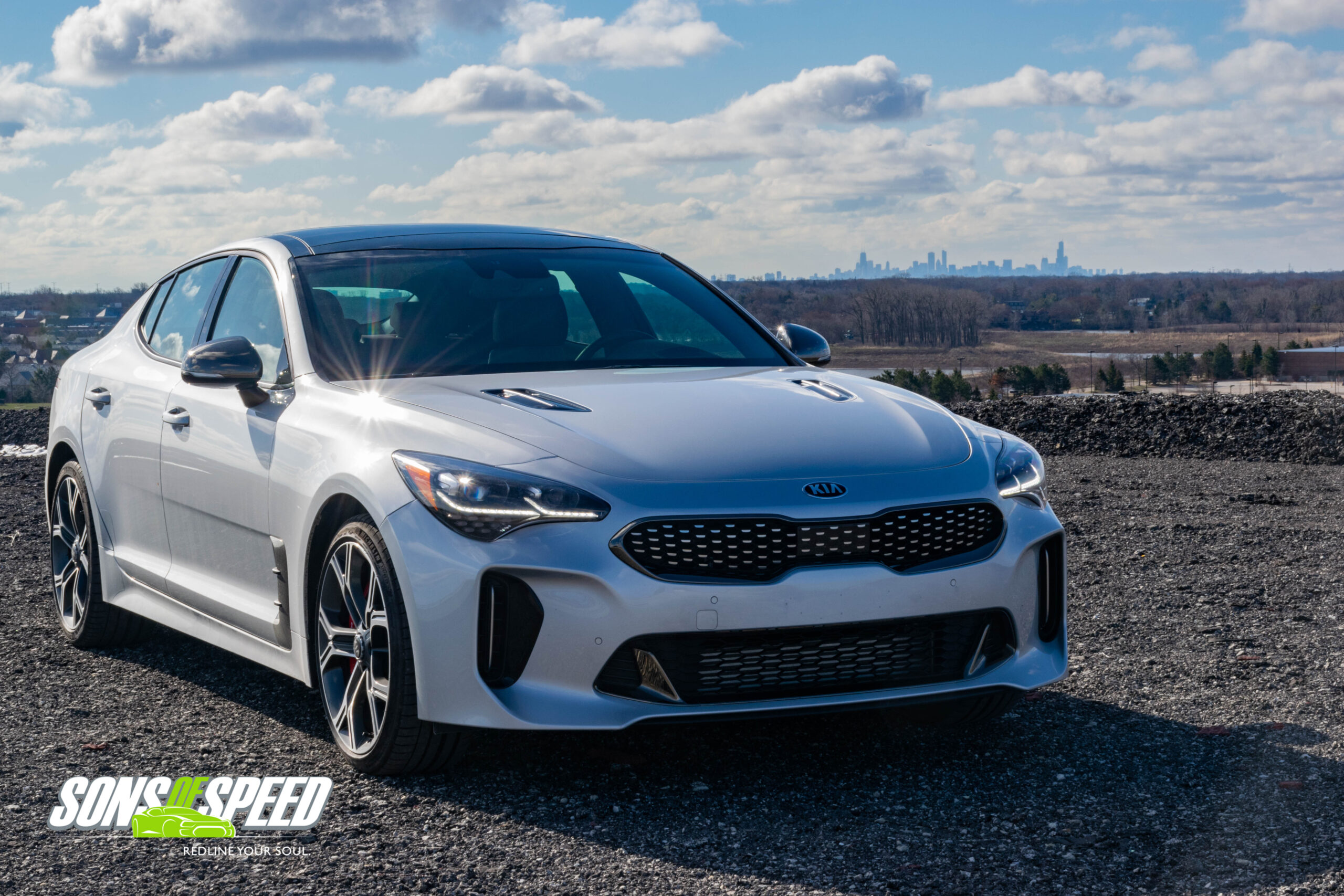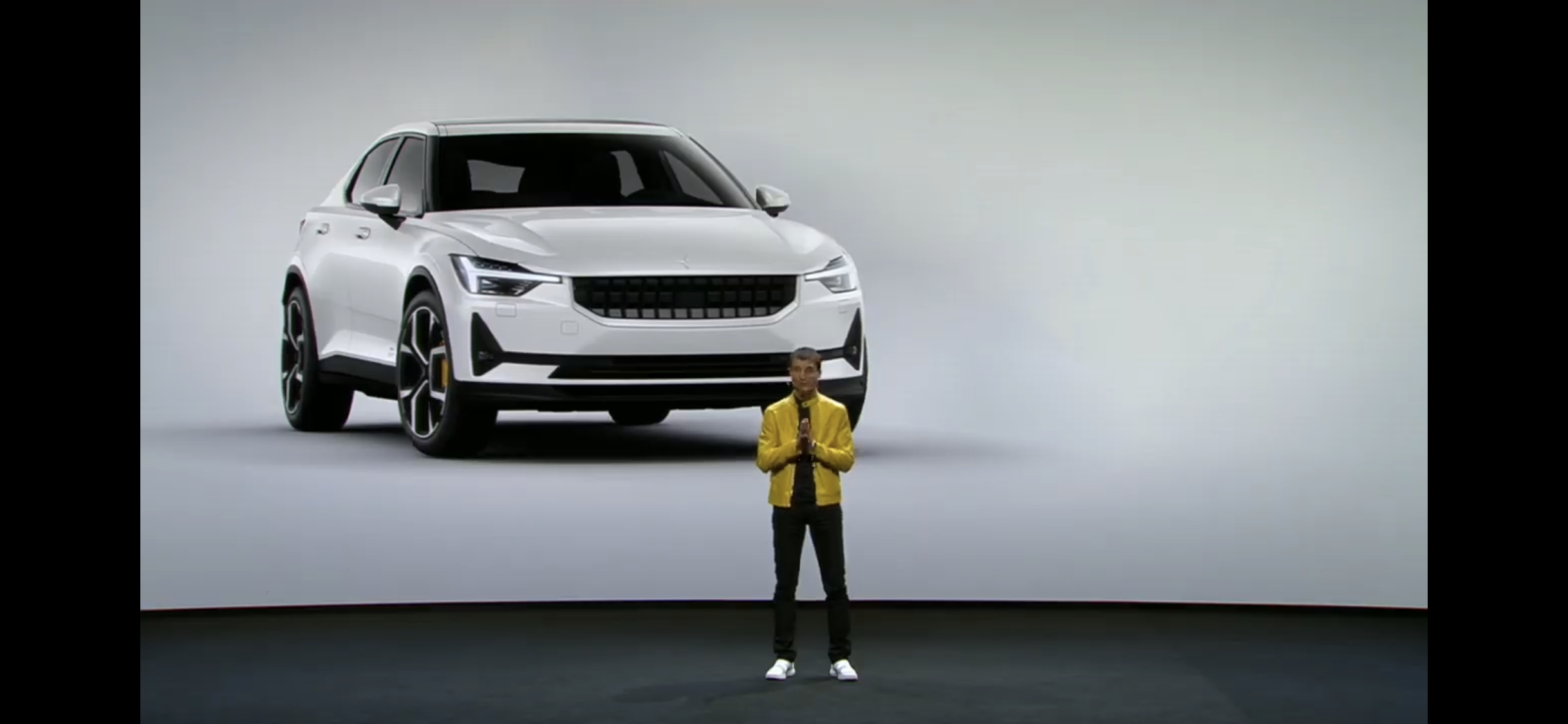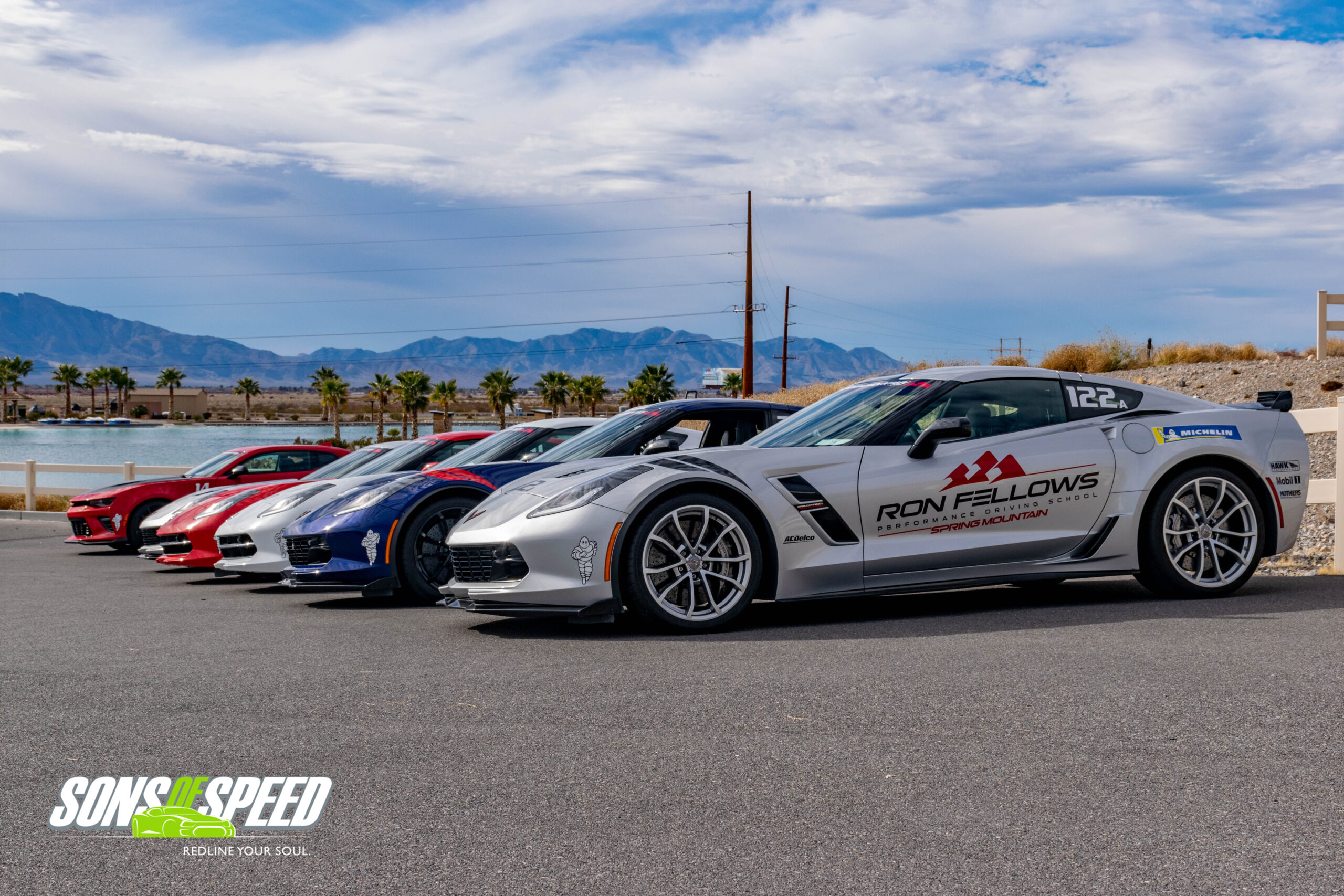
A Motorsports Oasis in the Desert
Nestled a mere hour west of bustling Las Vegas, Nevada lies a Mecca for motoring enthusiasts. While the town of Pahrump offers its own vices of casinos and even legal bordellos, for the auto enthusiast the sin to be indulged in this city is that of speed. Triple-digit, pulse-quickening, catch-me-if-you-can glorious speed. Because tucked into the Spring Mountains on the California-Nevada border is a country club without true equal the world over. You won’t find a caddy shack or driving range or nary a blade of real grass. Instead, you’ll find what is soon to become the longest racetrack in the world, surrounded by homes and condos of people who want to live with the sonorous melody of camshafts, rev-matching and bellowing exhausts. Here, you will find Spring Mountain Country Club, home of the Ron Fellows Performance Driving School.
Ron Fellows and the Owner’s School
For those unfamiliar, Ron Fellows is a Canadian-born race car driver who became one of the most successful Trans-Am drivers of all-time, winning 19 out of 95 starts. Fellows began racing Corvettes with the C5.R in 1998, an association that eventually led to his school’s long-standing affiliation with Chevrolet training new Corvette owners on the finer points of on-track car control.
Besides also schooling future racers on the Radical race car platform, Ron Fellows is the official high-performance school of Chevrolet and Cadillac’s highest performing sports cars. Included with the purchase of every Corvette, CTS-V and ATS-V is a free or discounted “Owner’s School”. For ZR-1 owners, the cost of the ZR1 owner’s school is included in the six-figure purchase price, along with a free night in a condo. For all other Corvette buyers, every purchase below the ZR-1 includes a discount on a 2-day Corvette Owner’s School, where the basics of car control and track techniques are taught using the school’s fleet of over 150 Corvette Stingrays, Grand Sport’s and Z06’s. Whatever the level of discount, all offers must be used within one year of original purchase and are not transferrable to another person. Back when I first visited the school in 2015, following the purchase of a Stingray Z51, students had the option of extending the two-day Owner’s school into a 3-day long Level One course, which added more track time and instruction for an additional $1500 or so. Due to a higher demand for the less expensive 2-day Owner’s School, the 3-day combo upgrade is no longer available. That leaves the program levels at the standard Owner’s School, Level One and then Level Two, although if you demonstrate enough skill at Owner’s School, you might be allowed to skip a grade right into Level Two. The school also offers private instruction (consisting of one-on-one coaching) to students of all skill levels.
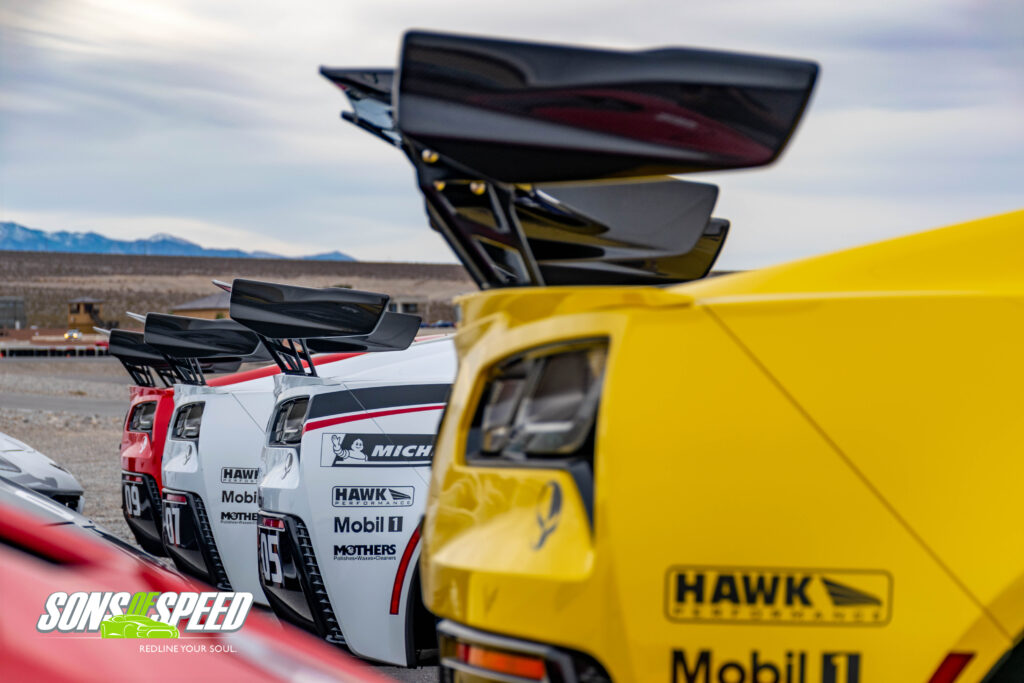
Ready Level One
The Level One experience was eye-opening. As someone who had driven many track days, it was humbling to drive lead-follow style while our instructors ran ahead, uncatchable I would add, in mere Camaro SS’s while simultaneously watching us in the rear view mirror, steering, shifting and holding a CB radio mic, with which they radioed precise instructions and critiques constantly. It is the automotive equivalent of explaining astrophysics while juggling chainsaws on a unicycle. Often times they performed this seemingly impossible feat with one of the participant’s significant others riding shotgun in their Camaro. The instructors were in slower cars, doing 3 things at once, and we mere humans struggled to keep up. Lesson one: there is so much left to learn.
And learn we did, not only how to find the lines on one of Spring Mountain’s many available configurations, but how to recognize the essence of each twist and turn in order to apply that recognition and knowledge to any future track. The Ron Fellows school is able to teach this skill thanks not only to its amazing staff of professional and talented drivers, but because Spring Mountain was literally created to offer every kind of feature you might encounter at other tracks. Undulating esses? Check. Carousels? Check. Throw-away corners? Check again. Increasing and decreasing radius turns? Double check, and so on. In fact, this was the primary skill I took away from my Level One experience, and I was soon able to apply it with my first trip to Gingerman Raceway in South Beloit, Michigan. Despite never having been to the track nor having anyone to show me the racing line, I was able to immediately and unconsciously apply the track-reading skills the Ron Fellows team instilled only a few months prior. It was a satisfying validation that the Ron Fellows teaching method really works.
Level 2, More Track Time and More Money
Fast forward to 2019, and I am once again returning to this desert oasis, courtesy of my having upgraded to the 2017 Grand Sport, which again came with a discounted visit to the school. This time, however, I was searching for more, and, thankfully, Ron Fellows can oblige its Level One alumni with its Level Two Corvette School. The cost is higher and, to be honest, not entirely fair for Grand Sport and Z06 owners (see below). As you can see, the amount of discount Chevy provides varies greatly depending on which level school you attend and which car you want to drive. At Level 2, Stingray drivers get an $1800 discount (kicked in by Chevy) off of Ron Fellow’s regular rates. But if you spent the extra dough to buy a Grand Sport or Z06, Chevy inexplicably reduces the amount of the discount to $1300 even though these buyers spent more money to purchase their cars. To keep costs in line, I was forced to forgo my preferred choice of driving a carbon copy of my Grand Sport, settling instead for another Z51 as before. All the cars are essentially stock, only adhering to Chevy’s track preparation instructions of a track alignment, track oil, high temp DOT 4 brake fluid and Hawk HP+ track pads for the Z51’s (the Grand Sport and Z06’s all being equipped with the Z07 package’s carbon ceramic brakes). All cars are equipped with the Corvette’s optional Performance Data Recorder (PDR) and a CB radio plugged into the car’s AUX input, which plays the signal through the C7’s speaker system. The system works perfectly and allows instructors to correct a student’s mistakes on track in real time, giving the student the chance to fix his or her errors by the next turn.
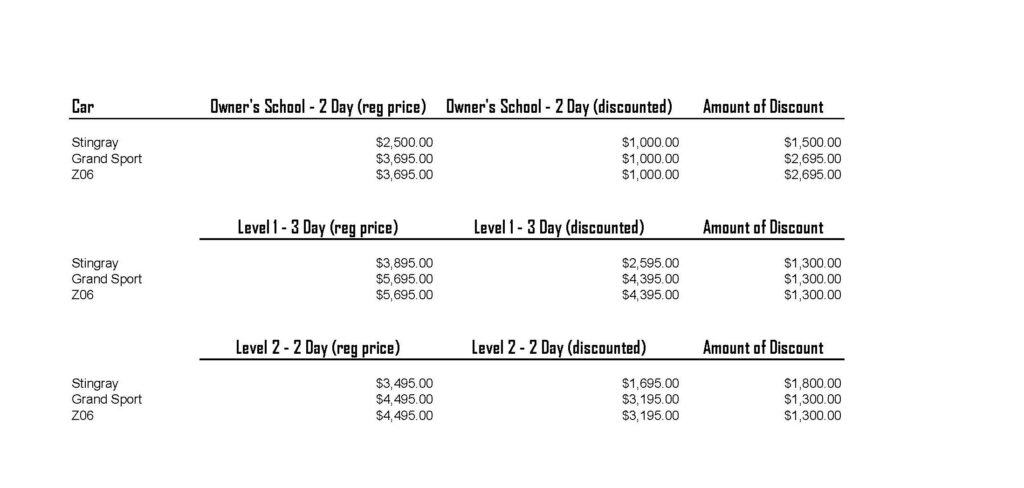
Speaking of instructors, our class of 16 students had seven instructors over the two days, and their constant rotation meant you never had the same instructor back to back. This method allows students to benefit from multiple points of view and teaching styles, but each instructor always added something useful in the never-ending quest to be faster and better. The school’s lead instructor Rick Malone, who taught most of my Level 1 school four years earlier, started us off and then handed the reigns over to another former pro-racer Richie Hearn, who took responsibility for our safety and our improvement over the next two days.
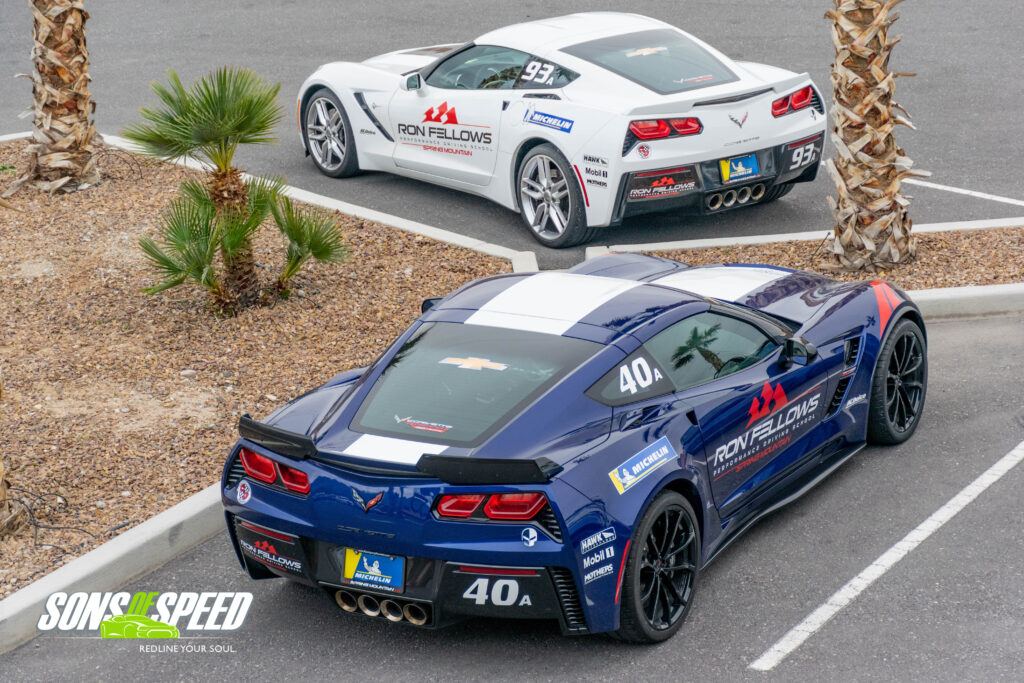
Amenities, Insurance and Swag
Checking in the night before, you are given the key to your own nicely appointed condominium unit (one night is included in the school with additional nights running $125-$200 per night). Soon, you’ll even be able to rent an entire house (several are currently under construction) for $350 per night. Registration for the school happens the next morning after the included hot breakfast, where you are literally asked the $6,000 question: would you like to buy down your deductible from $8,000 to $2,000 for an additional $200.00 in case you crash? Having successfully completed Level One and many track days since without incident, I declined, but other students (including one who totaled a car his last time at Spring Mountain) gladly accepted. We were given a badge with our name on it and a small water bottle that generally fits better in the C7’s cup holder than most others. This latter item summed up the swag Chevrolet provides its customers spending $60,000-$100,000+ on their vehicles. Cadillac, on the other hand, provides its attendees with a very nice jacket and hat for their customers spending roughly the same amount. This disparity can easily be attributed to relative sales numbers: Chevy has thus far averaged 28,940 C7 sales per year (even with the shortened 2018 model year), while AST-V and CTS-V sales have totaled only 9,024 over the past 3 years. Obviously, one brand needs more enticements than the other, and then there’s the luxury image Cadillac projects. Corvette is known as the performance bargain, and bargains don’t get free swag. Helmets and head socks (as well as breakfast and lunch) are provided, but you’ll want to bring your own 32GB SD card to record your adventures on track through the Performance Data Recorder, along with driving shoes, sunglasses and a hat to hide your helmet hair. A non-driving companion can take pictures and videos from trackside, or (space permitting) climb aboard with the instructors during the lead-follow sessions.
Day One
Level Two consists of two days, ditching the previously learned lessons on car control and wet braking at the skidpad that makes up most of day 1 on the lower-level schools. Day one, Level Two consists instead of a very brief classroom refresher before heading to the cars for a brief session on threshold braking and a heel-and-toe downshifting. After a short break to rehydrate (an absolute must in the desert no matter the temperature), it was out to the 2.2-mile long North/South track (one of 50 available configurations) for our first lead-follow session. As with Level One, this consists of rotating the students through the position immediately behind the instructor. Amazingly, while the bulk of instructors’ attention is focused on this first car, you still will hear them correcting the second car’s line as well.
Once sufficiently re-acclimated to the course, it was back to the classroom for a bit more instruction and hydration before several more exuberant lead-follow sessions, each one seemingly fixing another fault in my technique. At this level, track time is plentiful, and we barely felt like we caught our breath and grabbed a drink before it was time to head back out. After a full 8:00 am – 4:00 pm day, we were all physically and mentally drained. I and a group of my fellow students decided to recharge at Pahrump Valley Winery and Symphony’s Restaurant for beautifully prepared steaks and local wine while comparing notes on the day’s challenges. We all agreed, however, that an early turn in and good night’s sleep was preferred that night as the next day promised even more intense track driving.
Day Two
Day two began with a pleasant surprise: a timed autocross course featuring a 180-degree turnaround. We each were allowed two passes on cold tires, and even though the cars were in Sport 1 (allowing a bit of rotation before stability controls kicked in), I was able to successfully rotate around the 180 turn in a most satisfying mini-drift. I later learned that although cold-tire traction was minimal, my second run of 42.42 was quickest of the day by over half a second. Score one for the Sons of Speed.
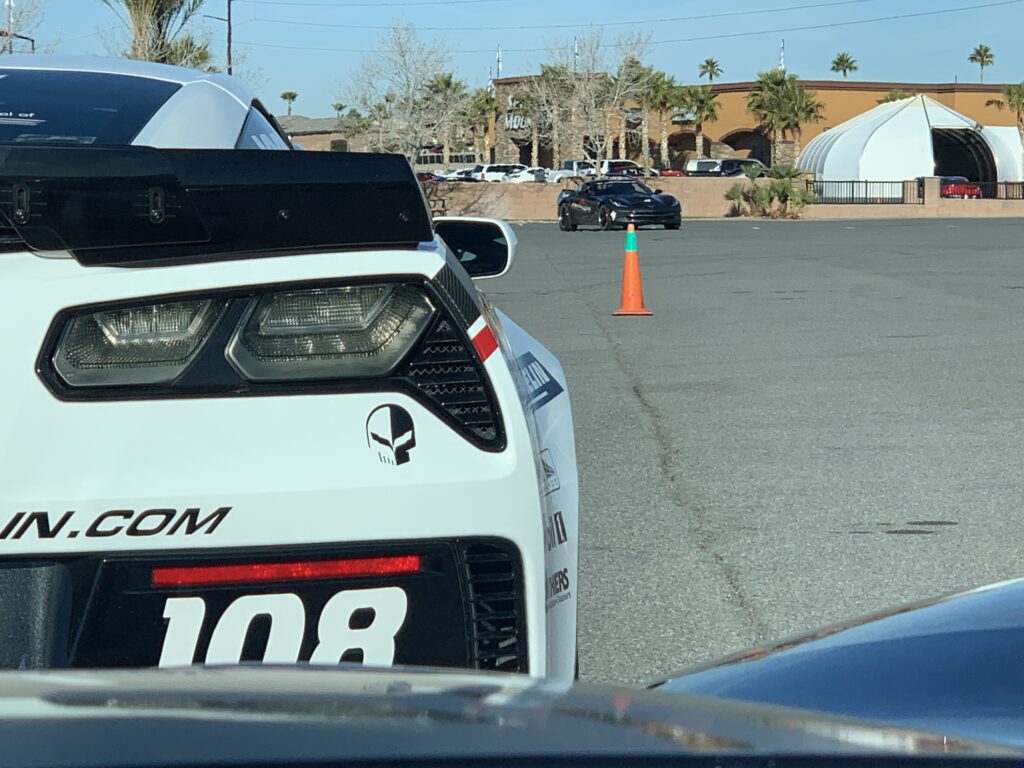
After warming the tires and frightening some cones, each car was fitted with a timing transponder and sent back to the track for an initially terrifying reverse lead-follow session. You see, until now we all had the benefit of following an instructor, or at least another student who was at least following another student who was following the instructor. This meant the race line and, most importantly, braking points were provided for us like a video game. Now, with the instructor following us, there was nothing to see in front of us but racetrack. As the instructors predicted, our first look at open track resulted in missed braking zones, turn in points, and apexes. One student right in front of me made it less than a lap in the lead when he mistook the turn-in cone at turn 3 for the braking cone and blazed an impromptu trail into the desert in his blue Stingray. We were directed off the track and back to the pits while the student was shuttled from his desert parking spot to the instructor’s passenger seat for the rest of the session. Fortunately, the car was in need of only an alignment and the student’s wallet was safe from his deductible. For our next session of follow-lead later that morning, he was back in the driver’s seat of his now white Corvette, as the school rightfully believes in a back- in-the-saddle philosophy to off-track mishaps.
After lunch (also included in your tuition), it was time for our graduation to open lapping, which is essentially a track day with one major difference: passing was handled by CB radio request rather than pointing a finger out the window. Also different is that the car being passed pulls off the racing line, whereas with most track days the overtaking car will move off the line. I must admit it incredibly satisfying to grab the CB and say, “Car 112, I need a pass after turn 7” and then watch that car dutifully move to the right. If only such a system were required for interstate travel, we might eliminate the left-lane hogs and road-rage once and for all.
Here was our time to apply all the skills our instructors had collectively hammered into our skulls over the past day and a half. But before we headed back out, we each had a personal session with an instructor at a laptop station, pouring over the data collected from our PDRs.
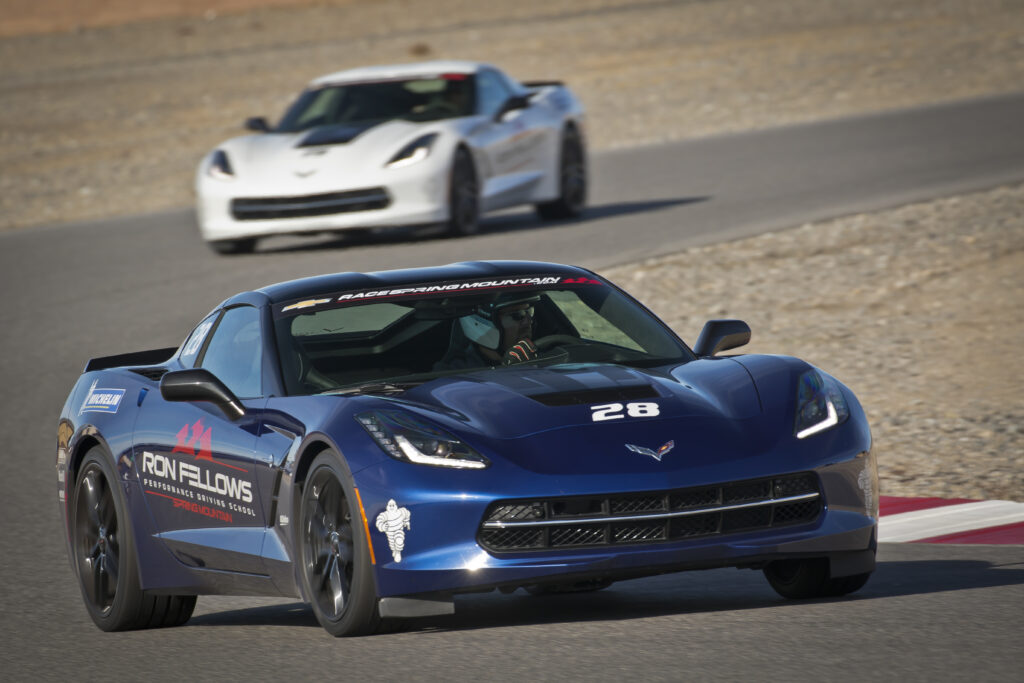
Performance Data Recorder Review – Learning Smarter, Not Harder
Using the free Cosworth toolbox software and PDR data card, we could see the exact line we took, when we hit the brakes and how hard, our speeds and G-Forces. By comparing our best laps with an instructor’s reference lap in real time right in the software, we were able to see exactly how and where we were losing valuable time around the track. I quickly found that in a few problem corners, I was braking too soon and losing too much speed, probably my subconscious reminding me I had not sprung for the additional crash coverage. My best time at this point was a 2:01.179 (while the instructor had ripped off a blistering 1:54.62). Using the lessons learned from the data, I was able to shave that down to a 1:59.382 my next time out. After an instructor jumped in the passenger seat for some additional fine-tuning, I dropped that time down to a best lap of 1:59.160. During these open lapping sessions, I was flogging the Stingray as hard as it would go and my skills would manage. Three such sessions later (with short 30 minute breaks in between), and I was simultaneously exhilarated and drained. The Stingray barely broke a sweat.
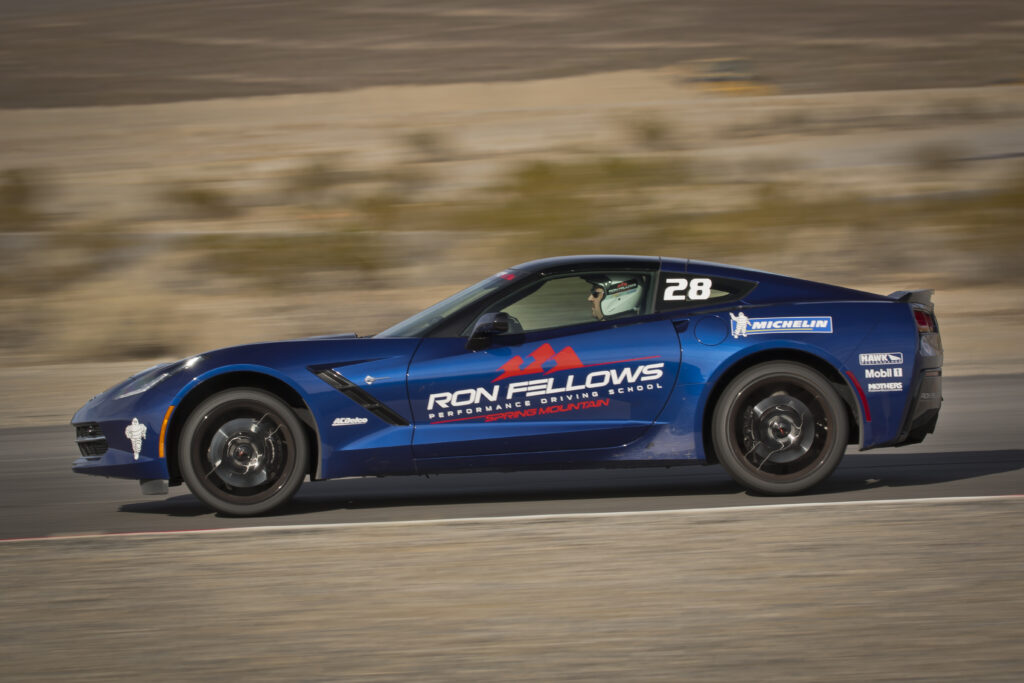
Graduation
After the final session, we gathered back in the classroom for graduation. All the instructors lined the front of the room for the ceremony. Each student received a certificate and a print-out of their lap times, and we shook each instructor’s hand as we worked our way down the line. Most students showed their appreciation by piling a good amount of cash on the counter as well. While they did announce the top three times for the autocross, no such announcement was made for the track sessions. Apparently, some past bruised egos ended the public announcement of lap times (always a bad apple). Nonetheless, I did figure out later that one driver had bested me by less than a second, turning in a time somewhere in the 1:58’s, also in a Stingray. I’ll chalk that up to my tires being more worn and keep my ego intact. Seriously though, we were told early on that any time at or under 2:00 by a student was considered fast, so I walked out of graduation knowing I had learned much and done well. It was interesting to note that the best times were not in the more powerful Z06’s, as each student with one of the beasts reported issues putting the power down. The car’s additional weight also didn’t help its cause around the relatively tight course. While no one in the group had popped for the Grand Sport, Richie, our lead instructor, opined it would have likely turned in the fastest time of all. As a Grand Sport owner myself, I whole-heartily agree.
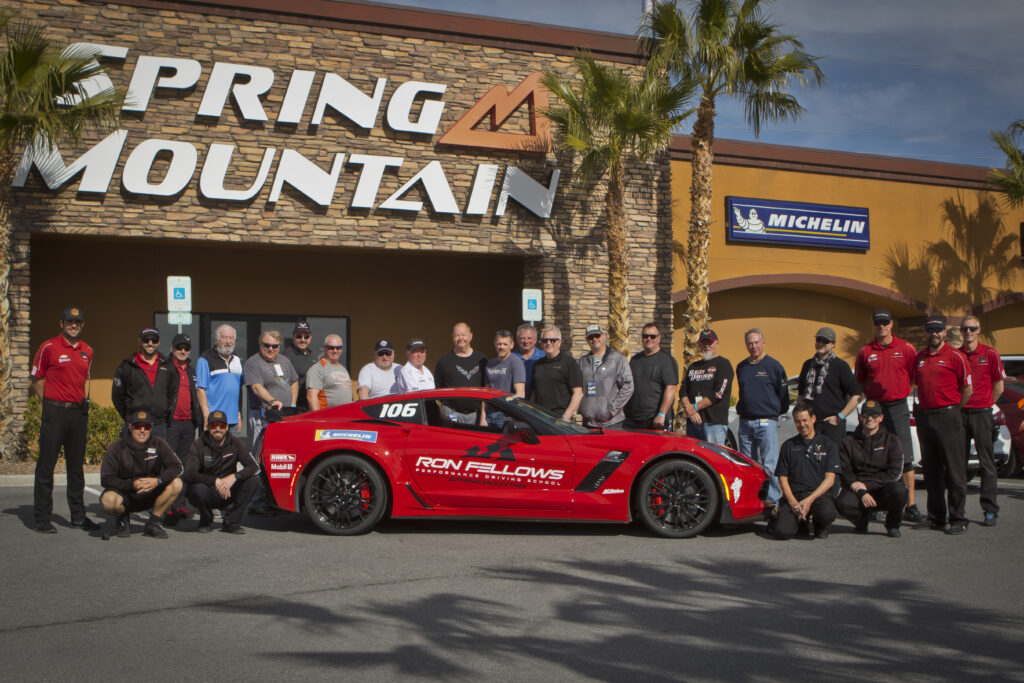
More Than Just a Racetrack
Now, if all this were all Spring Mountain had to offer, it would be more than enough for petrolheads like us, but while this country club has no golf course, it does boast a lake with a sandy beach, water sports, and even jet-pack rides. The 8,000 square foot clubhouse offers a place for meals and libations, and there is a pool, workout facility and even a firing range on the property.
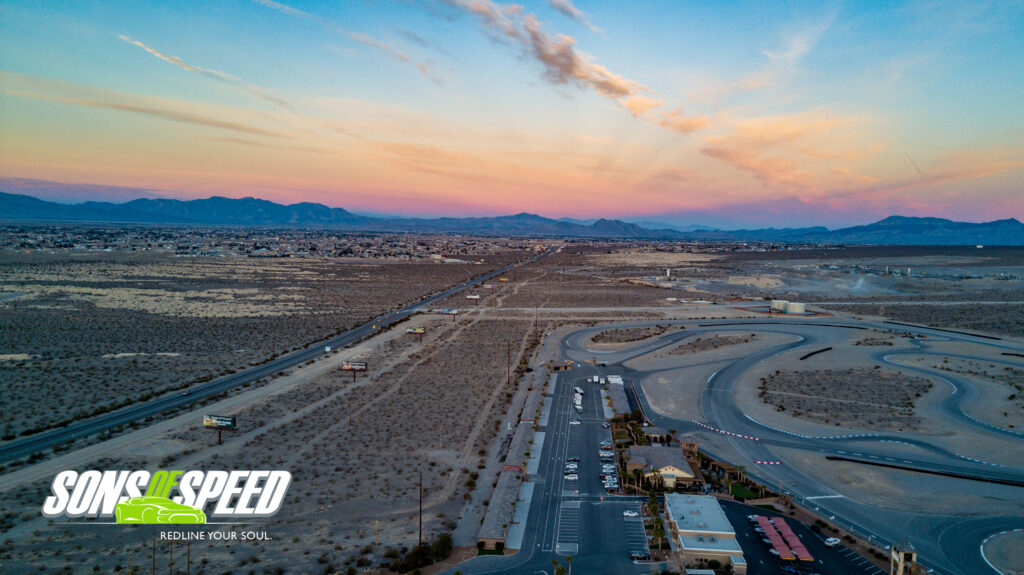
More to See and Do
If you’re planning a trip to Spring Mountain, its proximity to Sin City almost requires a few nights stay there before or after the school, where in addition to the shows and casinos, you can excise your inner soldier at a place like Machine Gun Vegas. Before heading to the track, I popped into MGV and sampled a variety of full-auto machine guns from an Uzi to an AK-47, and I can highly recommend it for satiating your adrenaline needs. You can also visit nearby Death Valley, Lake Mead and Hoover Dam, and even the Grand Canyon isn’t that far.
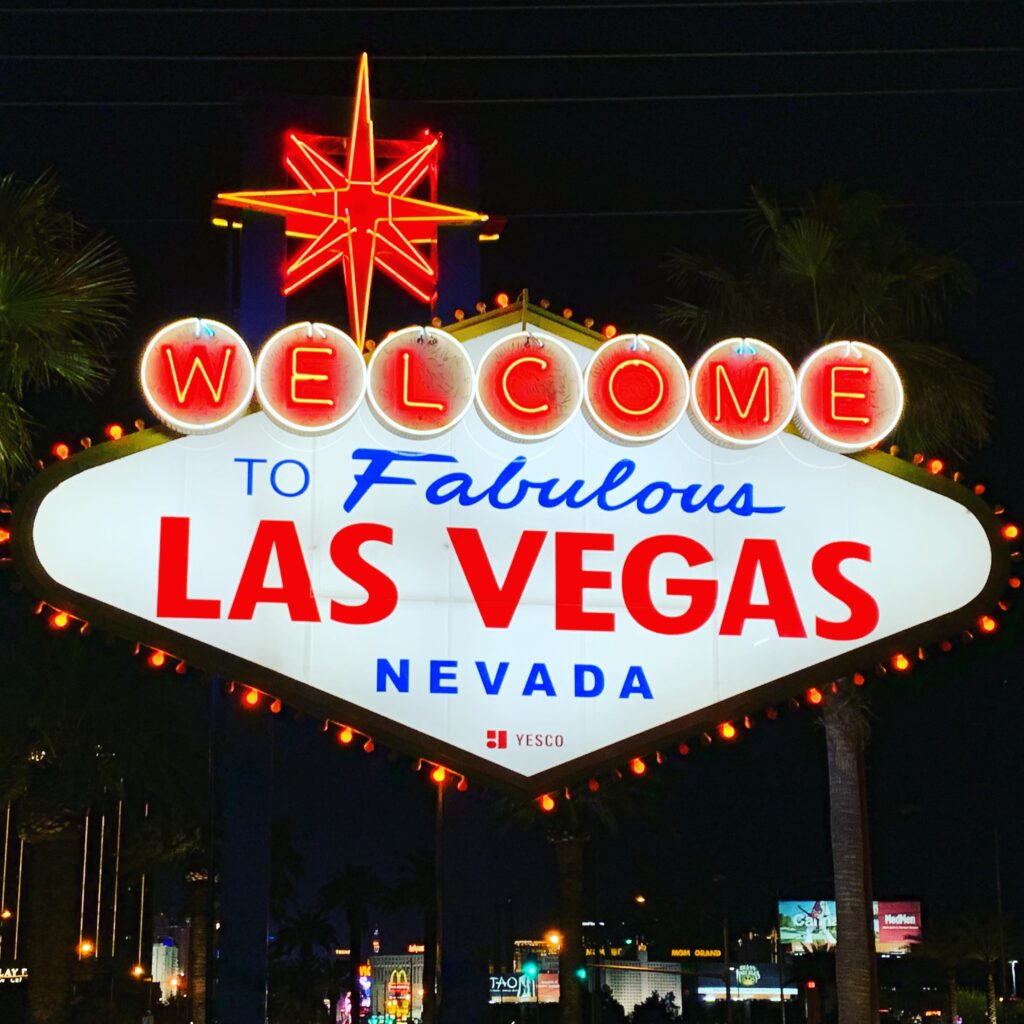

Soon to be the Longest Racetrack in the World
Spring Mountain Country Club will be rapidly expanding over the coming years across 620 adjacent acres of desert. There will be an independent go-cart track, more classroom space, new paddock space, a commercial retail center with restaurants, a 125-room hotel and casino, and even a drag strip. In 2019, the club begins construction on a 3.02-mile track extension, which with further extension plans will eventually increase the total track length from 6 miles to a world record 16 miles of racetrack. Spring Mountain is home to many motorsport events, club racing and track day rentals, but members are guaranteed at least 16 track days per month to hone their skills. Charter memberships cost $60,000 plus $6,000 in annual dues, and a membership is required to purchase a lot in Spring Mountain Estates. Lots there start at $275,000 for 1/3 an acre with average lots measuring 110ft x 110ft square. No one ever said that paradise was going to be cheap, but for a total entry cost of $335,000 (plus the cost of building a home), you can own a piece of what will surely become a required stop on any track rat’s bucket list.
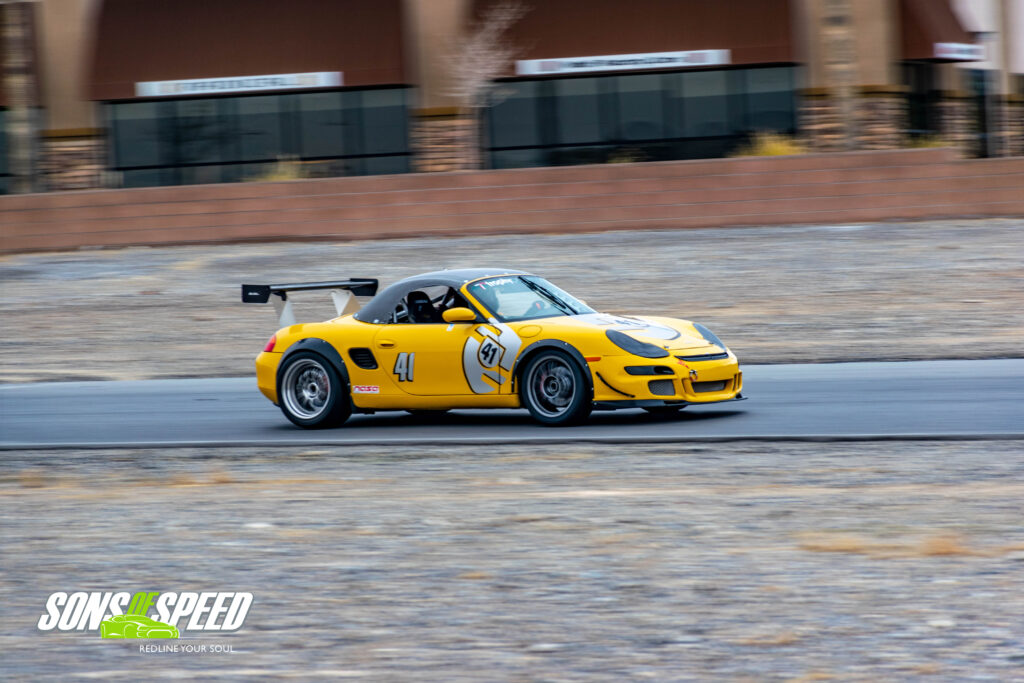
What’s Next?
If you are a Corvette owner, or just want to get better at driving on track, the Ron Fellows School is a must, and the instruction quality and levels of progression ensure you continue to improve in skill along the way. The only question is will Ron Fellows offer a higher-level school? Rick Malone can’t say for sure, but the school is always looking at student interest levels. We would suggest adding a Level Three school where students would leave waving their newly minted racing license – how cool would that be? And hey, it would certainly bring me back again!

